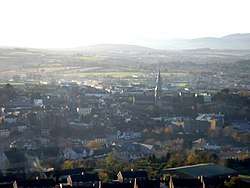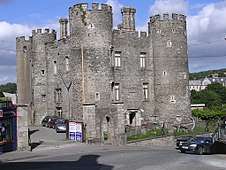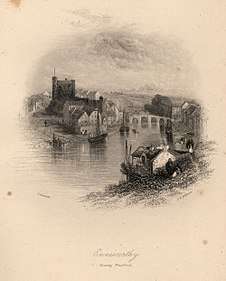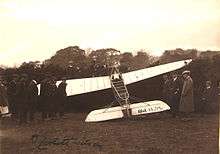Enniscorthy
Enniscorthy (Irish: Inis Córthaidh)[2] is the second-largest town in County Wexford, Ireland. At the 2016 census, the population of the town and environs was 11,381. The town is twinned with Gimont, France.[1] The Placenames Database of Ireland sheds no light on the origins of the town's name. It may refer either to the "Island of Corthaidh" or the "Island of Rocks". The cathedral of the Roman Catholic Diocese of Ferns is located in the town.
Enniscorthy Inis Córthaidh | |
|---|---|
Town | |
 Enniscorthy from nearby Vinegar Hill | |
 Enniscorthy Location in Ireland | |
| Coordinates: 52.502064°N 6.565876°W | |
| Country | Ireland |
| Province | Leinster |
| County | County Wexford |
| Elevation | 60 m (200 ft) |
| Population (2016)[1] | |
| • Total | 11,381 |
| Time zone | UTC±0 (WET) |
| • Summer (DST) | UTC+1 (IST) |
| Eircode routing key | Y21 |
| Telephone area code | +353(0)53 |
| Irish Grid Reference | S969399 |
History

Enniscorthy Castle
Enniscorthy Castle is an imposing Norman stronghold, which dates from 1205 and was a private dwelling until 1951. The castle was built by the DePrendergasts. In the early 1580s, the poet Edmund Spenser leased the property that included the castle.[3]
The castle was also once owned by Sir Henry Wallop. The castle was the site of many fierce battles during the Cromwellian years and also during the 1798 Rising. The castle houses the Wexford County Museum, which contains extensive 1798 rebellion-related material, as well as items of local and agricultural interest. It was closed for major refurbishment from 2007 until May 2011.
Vinegar Hill

Vinegar Hill (Cnoc Fhiodh na gCaor in Irish which translates as 'hill of the berry-tree'), a pudding-shaped hill overlooking the town, was the largest camp and headquarters of the rebels of 1798 who controlled County Wexford for thirty days against vastly superior forces, before their defeat on 21 June. However, many managed to flee south through a gap left in the British lines by General Needham (now known as Needham's Gap). During this time, Beauchamp Bagnell Harvey was declared President of the Wexford Republic.
1798 Visitor Centre (Áras 1798)
_p126_Destruction_of_the_Church_of_Enniscorthy.jpg)
The 1798 Visitor Centre is devoted to the history and aftermath of the 1798 Rising, setting it in its European context. It is housed in the former Congregation of Christian Brothers monastery.[4] The Visitor Centre offers people the chance to see what famous figures were involved in the 1798 Rising.
Saint Aidan's Cathedral

Following the relaxation of the Penal Laws at the beginning of the 19th century, it became possible for the Roman Catholic community to consider building a cathedral to replace the one in Ferns that had been appropriated for use by the Church of Ireland during the English Reformation. Built in 1843, St. Aidan's Cathedral[5] was designed by Augustus Welby Pugin, famous for having designed London's Houses of Parliament. The cathedral is in the same Neo-Gothic style. Notable features include the striking façade, a reredos carved from Caen stone and a great north window with intricate stone tracery. The cathedral was subsequently much renovated (in line with reforms promulgated by the Second Vatican Council). It was restored to its near original design in 1994 when authentic colours, materials and techniques were used. The restoration took a year, during which time cathedral services were held at St Mary's church (Church of Ireland) nearby.
1916 Rising
In 1916 Enniscorthy patriots again took their place in history, when James Connolly requested that the Enniscorthy Volunteers take and hold the railway line to prevent reinforcements from reaching Dublin. 600 Volunteers took the town, led by Robert Brennan, Seamus Doyle and J R Etchingham, they surrounded the police station but did not attempt to take it. The RIC barracks was held by a police inspector and five constables while a RIC sergeant and one constable prevented the rebels from taking over a bank in the town. They established their headquarters at the Athenaeum, and held control until asked to surrender by Padraig Pearse.
The Volunteers also established a strong position on Vinegar Hill, overlooking the town. The railway line was cut and men dispatched to Gorey and Ferns. The government responded by sending a force of more than 1,000 men to retake Enniscorthy and the rebels retired to their positions on Vinegar Hill. Before hostilities could develop, the news of the Dublin surrender arrived, but the Volunteers refused to believe it. To avoid bloodshed, the army commander Col. F A French offered safe conduct for the Wexford leaders so that they could go to Dublin and hear of the surrender directly from Pearse. There were no fatalities.

Early aviation

The first successful flight from Britain to Ireland was made from Goodwick's Harbour Village on 22 April 1912 by Denys Corbett Wilson, flying a Bleriot XI. The flight lasted one hour 40 minutes, with landfall near Enniscorthy, Ireland. The achievement was commemorated in Centenary Celebrations held in Fishguard and Goodwick on the weekend of 21/22 April 2012 and in a specially commissioned stage play by Derek Webb, called '100 Minutes' which was performed in Fishguard and Wexford the same week.[6]
Amenities
Enniscorthy is situated by the River Slaney, and has short walks beside it to the north and to the south, on the west bank. It is the cathedral town of the Diocese of Ferns and has two Catholic churches spread over two parishes — St. Aidan's and St Senan's, under the shadow of Vinegar Hill. The town also has a Church of Ireland, a joint Methodist/Presbyterian church, a non-denominational Christian Alive Church, a Society of Friends meeting hall, and a Masonic Lodge.
There is a swimming pool/recreation centre, several sports grounds including a rugby club and GAA club and several hotels including the four-star Riverside Park Hotel. Outside of the town, there is an 18-hole golf course, several pitch and putts, freshwater fishing, and a five-star spa, Monart, is beside "The Still Pond". The town also has several historical sites and museums.
Events
Festivals which take place locally include the Strawberry Fair, which is an annual event and takes place in the last week of June. It consists of amusements in Bellfield, live bands and the crowning of the Strawberry Queen in the square.
The Blackstairs Blues festival is also an annual event and includes international and local performers, in a variety of late-night concerts and workshops. Another music event, the Enniscorthy Street Rhythms and Dance Festival, takes place during two weekends in August and includes a parade, fireworks, a concert, and dance workshops.
Education
Enniscorthy has four second-level schools: Coláiste Bríde, St. Mary's CBS, Enniscorthy Vocational School and Meánscoil Gharman.
Arts and entertainment
The town's main visual arts and entertainment venue, the Presentation Arts Centre, is situated on the site of a former convent.[7][8] It is a multi-use arts venue which is developed and promoted by the Wexford Arts Centre and Wexford County Council.[9]
In literature, Enniscorthy is mentioned in the Ithaca chapter of James Joyce's Ulysses (p. 812) as a flyleaf note in a book belonging to Leopold Bloom, where it is described as "Ennifcorthy, County Wexford, the finest place in the world" (sic).
Enniscorthy is also the home of Eilis Lacey, the central character of the novel Brooklyn and its film adaptation. In the story, which is set in the early 1950s, Eilis travels alone from Enniscorthy to Brooklyn because of the lack of opportunities for her at home. Enniscorthy is credited as one of the filming locations for the movie. [10]
Economy
Davies Distillery
As early as 1824 Francis Davies, a Miller, operated a spirit business from his mill in Enniscorthy.[11] Davies then employed John Mullaly as a distiller. Mullaly had previously worked as a distiller with John McKenzie & Co in Mill Street Belfast. When the temperance reformer Theobald Mathew campaigned against alcohol, many distilleries in Ireland closed.[12] After the Davies distillery closed, Mullaly and his family cast their lots together and emigrated to Australia on the Salsette in 1840.[13]
George Killian's Red
Enniscorthy was the location of a regional microbrewery opened in 1864 and owned by the descendants of George Killian Lett. During their operation, Killian's ale was sold almost entirely in Wexford county. GH Lett Company still operates today, but no longer brews its own products. They now focus on wholesale to shops, bars and hotels.[14] Killian's Red is still sold abroad, and the brand is currently held by Brasseries Pelforth, S. A.
Pottery
Carley's Bridge Pottery is one of Ireland's oldest potteries, having made earthen pots for over three hundred years. Paddy Murphy was also an Enniscorthy potter and in 1980 founded Hill View pottery adjacent to his home and close to Carley's Bridge Pottery. The cul de sac "Potters' Way" is named after him — as he would walk that route to his home. Since his passing, Hill View pottery has been taken over by his relation Derek O'Rourke.
Enterprise Centre
Enniscorthy Enterprise & Technology Centre provides business support and training for small and medium enterprises.
Transport
Enniscorthy railway station is on the Dublin–Rosslare line. The line terminates Dublin Connolly railway station in the northern direction, whilst in the southern direction it runs to Rosslare Europort, where it connects with the Stena Line ferry to Fishguard Harbour. For connecting trains to Swansea and Cardiff Central for London Paddington. There are also Irish Ferries connections from Rosslare Europort to Pembroke and Cherbourg. The station opened on 16 November 1863.[15]
There is a bus stop at Templeshannon with connections to Dublin and other cities.
In October 2015, work began on the Enniscorthy Bypass. The bypass consists of 27km of motorway that connects the N11 with the M11 motorway just north of Oilgate. This motorway is located to the east of Enniscorthy; allowing motorists to stay clear of the town centre. The project, which was officially opened on 18 July 2019, also includes a single carriageway that connects the N30 with the M11.[16]
Sport
The local Gaelic Athletic Association (GAA) clubs include the Shamrocks and the Rapparees/Starlights. These two town-based clubs compete in both hurling and Gaelic football. St. Patrick's Park is the name of the local GAA grounds.
People
- Wallis Bird, singer
- Martin Cash, a transported convict who became a bushranger in Van Diemen's Land (now Tasmania, Australia) was born in Enniscorthy in 1808
- Anthony Cronin, poet and biographer of Flann O'Brien and Samuel Beckett, is a native of Enniscorthy
- Maria Doyle Kennedy, Irish singer and actress who lived in the town as a child
- James Edmond (1822–1890), pioneering gold prospector in Australia, Eureka Rebellion leader
- William Henry Grattan Flood (1859–1928), a prolific author, historian and musicologist, resided in Enniscorthy from 1895 until his death in 1928
- Eileen Gray was born in Brownswood and later became famous as a furniture designer and architect
- Daryl Jacob, jockey and rider of the winning horse in the 2012 Aintree Grand National is from Enniscorthy
- Bill Lacey, dual international footballer, who played for both Liverpool F.C. and Everton FC in the early 20th century
- Adam Nolan, a welterweight boxer who represented Ireland at the 2012 Olympics
- Colm Tóibín, born in the town, has written several novels set in the area
- Brothers Charles (1836–1912) and Richard Reeves (1836–1910), who emigrated to New Zealand, were born in Enniscorthy
- Gerard Whelan, author, was born and lives in Enniscorthy
International relations
Enniscorthy is twinned with Gimont in France.[17][18] Enniscorthy was also the host town of the team and supporters from Canada during the 2003 Special Olympics.
See also
References
- "Sapmap Area – Settlements – Enniscorthy". Census 2016. CSO. 2016. Retrieved 12 January 2018.
- "Placenames Database of Ireland". Archived from the original on 27 May 2012. Retrieved 13 July 2010.
- Oxford DNB
- Visitor Centre
- St. Aidan's Cathedral
- Western Mail article; Goodwick marks centenary of first flight
- "The Presentation Arts Centre". www.presentationcentre.ie. The Presentation Arts Centre.
- "Presentation Convent, Francis Street, Townparks (part of St. Peter's Parish), Wexford, County Wexford". www.buildingsofireland.ie. National Inventory of Architectural Heritage.
- "Wexford Arts Centre". www.wexfordartscentre.ie.
- "Brooklyn filming locations".
- Piggots Directory 1824
- Father Mathew a Biography – John Francis MacGuire (Longman Green, Longman, Roberts and Green Lon 1863
- Passenger list Salsette
- Gofree.indigo.ie Archived 27 September 2007 at the Wayback Machine, Lett's Website
- "Enniscorthy station" (PDF). Railscot – Irish Railways. Retrieved 7 September 2007.
- "Enniscorthy Bypass". Retrieved 27 October 2015.
- "Enniscorthy Twinning" (PDF). Wexford County Council Report (page 108). Archived from the original (PDF) on 4 October 2008. Retrieved 23 June 2008.
- fr:Gimont
External links
| Wikimedia Commons has media related to Enniscorthy. |
